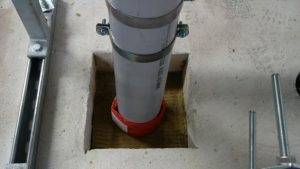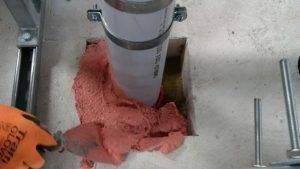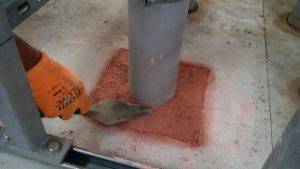How do you firestop a plastic pipe through an oversized hole within a concrete floor penetration? Tested Detail Queries
There are often times where the positioning of a plastic pipe may not be accurate enough to determine the location of a correctly sized aperture for the plastic pipe. Therefore, an oversized hole may have to be formed to allow a measure of tolerance for the M&E contractor.
So, how would you go about sealing this oversized hole?
Quelfire have a variety of tested firestopping solutions that could be considered, but an application commonly used by firestoppers is detail QF2-CF150-08. This detail is one of our QF2 Fire Protection tested applications.
The Quelfire products needed are the:
The below step-by-step application utilises a 110mm plastic pipe penetrating an oversized hole through a concrete floor slab, with a depth of 150mm.
Firstly, the MW Mineral Wool Shuttering Slab is installed on the lower side of the concrete floor. It will be slightly larger than the aperture but is employed to achieve a snug, compressed fit. The shuttering slab should be flush with the underside of the concrete slab, leaving a 100mm gap above.
Next, the QWW Intuwrap is installed around the plastic pipe, directly on top of the shuttering slab. It is secured in place using the self-adhesive tab provided with the product.

*Please note that the intumescent must remain inside the orange polythene bag. It does not need to be removed.
The wrap must sit securely on top of the shuttering slab so that when the QF2 Fire Protection Compound is poured into the aperture, it will be flush with the bottom edge and visible from the underside once the shuttering slab is removed or cut back. It should not be protruding or setback within the compound.
The compound can then be poured into the aperture around the fire wrap, to a minimum depth of 100mm. Mixing ratios for the compound can be found using the QF2 Fire Protection Compound Installation Instructions to allow for different consistencies.

Once fully cured, the compound will provide a fire-resistant and load-bearing seal. The initial curing will take approximately 24 hours, reaching its full load-bearing strength after 28 days. However, this does depend on site conditions.

The shuttering slab can remain in place, but we do recommend that you cut it back to expose the fire wrap. This ensures the wrap is visible to anyone carrying out inspections, and the intumescent is exposed and able to react to the heat of the fire, closing the void that is created as the plastic pipe softens and melts away.
*Please note that if any other shuttering materials are used, such as plywood, the shuttering slab should be removed once the compound has cured.
Watch the video:
For any further questions about this detail, please don’t hesitate to contact us at technical@quelfire.co.uk.

